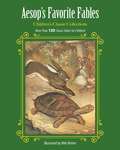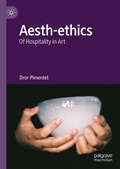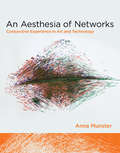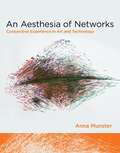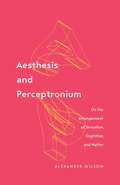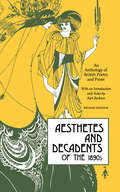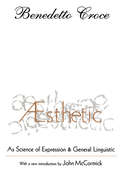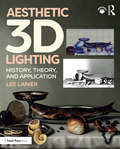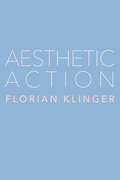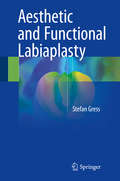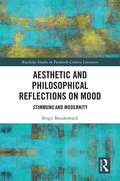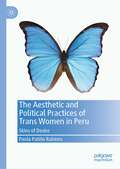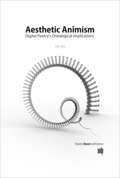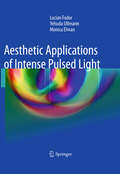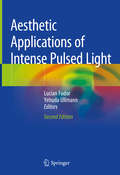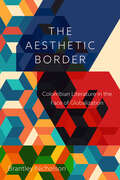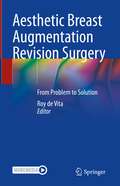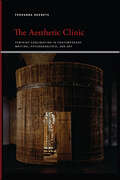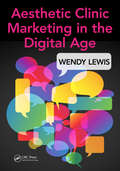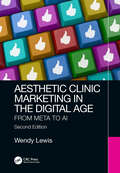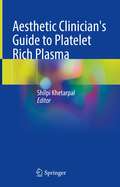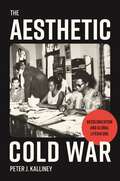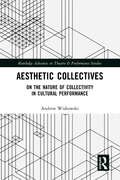- Table View
- List View
Aesop's Favorite Fables: More Than 130 Classic Fables for Children!
by Milo WinterRacehorse Publishing’s Children’s Classic Collections is a new series that offers readers timeless compilations of children’s literature. Handsomely packaged and affordable, this new series aims to revitalize these enchanting works and continue the tradition of sharing them with the next generation.Passed down for thousands of years, Aesop’s Fables is a collection of moral stories by the famed storyteller from ancient Greece. Reprinted and translated thousands of times over the past two millennia, this collection represents some of the most widely known and famous children’s literature. Many of these fables bestow human traits upon animal characters and place them in human situations to highlight desirable and less desirable traits. Their intent, through the telling of these tales, is to teach readers important moral lessons such as "Self-help is the best help” or "Do not attempt too much all at once.”Accompanied by beautiful color illustrations by renowned illustrator Milo Winter, this premiere collection of Aesop’s Favorite Fables is sure to ignite young imaginations and educate readers about virtue, kindness, integrity, problem-solving, happiness, and what it means to be human.
Aesth-ethics: Of Hospitality in Art
by Dror PimentelThe question of hospitality is the most pressing question in contemporary thought: How can we host that which is utterly Other, that which resists all conceptualization, and thus disrupts the proper course of thought? In the current book, the discussion of hospitality is given a new conceptualization, and extended to the field of aesthetics: the event of hospitality does not occur in the face-to-face encounter with the other person, as Emmanual Levinas conceived of it, but rather in the encounter with the work of art itself. Writing about the event of hospitality—as it is eventuated in art—involves subverting the traditional precedence of theory over practice. This subversion is also evident in the indifference to traditional distinctions, such as those between poetry and visual art; modern art and classical art; international art and local art. Moreover, most of the artworks considered throughout are hybrid in character: they are suspended in the space between the visual and the verbal, whether they involve the verbal representation of a visual object (as in Rilke’s poem “Archaic Torso of Apollo”), or a visual representation of a verbal object (as in Anselm Kiefer’s work “Your Golden Hair Margarete”). The consideration of these and other works come together to give rise to a novel and original discourse on art that is termed “Aesth-ethics,” and which is presented for the first time in this volume.
An Aesthesia of Networks: Conjunctive Experience in Art and Technology (Technologies of Lived Abstraction)
by Anna MunsterThe experience of networks as the immediate sensing of relations between humans and nonhuman technical elements in assemblages such as viral media and databases.Today almost every aspect of life for which data exists can be rendered as a network. Financial data, social networks, biological ecologies: all are visualized in links and nodes, lines connecting dots. A network visualization of a corporate infrastructure could look remarkably similar to that of a terrorist organization. In An Aesthesia of Networks, Anna Munster argues that this uniformity has flattened our experience of networks as active and relational processes and assemblages. She counters the “network anaesthesia” that results from this pervasive mimesis by reinserting the question of experience, or aesthesia, into networked culture and aesthetics.Rather than asking how humans experience computers and networks, Munster asks how networks experience—what operations they perform and undergo to change and produce new forms of experience. Drawing on William James's radical empiricism, she asserts that networked experience is assembled first and foremost through relations, which make up its most immediately sensed and perceived aspect. Munster critically considers a range of contemporary artistic and cultural practices that engage with network technologies and techniques, including databases and data mining, the domination of search in online activity, and the proliferation of viral media through YouTube. These practices—from artists who “undermine” data to musicians and VJs who use intranetworked audio and video software environments—are concerned with the relationality at the core of today's network experience.
An Aesthesia of Networks
by Anna MunsterToday almost every aspect of life for which data exists can be rendered as a network. Financial data, social networks, biological ecologies: all are visualized in links and nodes, linesconnecting dots. A network visualization of a corporate infrastructure could look remarkably similarto that of a terrorist organization. In An Aesthesia of Networks, Anna Munsterargues that this uniformity has flattened our experience of networks as active and relationalprocesses and assemblages. She counters the "network anaesthesia" that results from thispervasive mimesis by reinserting the question of experience, or aesthesia, into networked cultureand aesthetics. Rather than asking how humans experience computers and networks, Munster asks hownetworks experience -- what operations they perform and undergo to change andproduce new forms of experience. Drawing on William James's radical empiricism, she asserts thatnetworked experience is assembled first and foremost through relations, which make up its mostimmediately sensed and perceived aspect. Munster critically considers a range of contemporaryartistic and cultural practices that engage with network technologies and techniques, includingdatabases and data mining, the domination of search in online activity, and the proliferation ofviral media through YouTube. These practices -- from artists who "undermine" data tomusicians and VJs who use intranetworked audio and video software environments -- are concerned withthe relationality at the core of today's network experience.
Aesthesis and Perceptronium: On the Entanglement of Sensation, Cognition, and Matter (Posthumanities #51)
by Alexander WilsonA new speculative ontology of aesthetics In Aesthesis and Perceptronium, Alexander Wilson presents a theory of materialist and posthumanist aesthetics founded on an original speculative ontology that addresses the interconnections of experience, cognition, organism, and matter. Entering the active fields of contemporary thought known as the new materialisms and realisms, Wilson argues for a rigorous redefining of the criteria that allow us to discriminate between those materials and objects where aesthesis (perception, cognition) takes place and those where it doesn&’t. Aesthesis and Perceptronium negotiates between indiscriminately pluralist views that attribute mentation to all things and eliminative views that deny the existence of mentation even in humans. By recasting aesthetic questions within the framework of &“epistemaesthetics,&” which considers cognition and aesthetics as belonging to a single category that can neither be fully disentangled nor fully reduced to either of its terms, Wilson forges a theory of nonhuman experience that avoids this untenable dilemma. Through a novel consideration of the evolutionary origins of cognition and its extension in technological developments, the investigation culminates in a rigorous reevaluation of the status of matter, information, computation, causality, and time in terms of their logical and causal engagement with the activities of human and nonhuman agents.
Aesthetes and Decadents of the 1890s: An Anthology of British Poetry and Prose
by Karl BecksonThe Aesthetic and Decadent Movement of the late 19th century spawned the idea of "Art for Art's Sake," challenged aesthetic standards and shocked the bourgeosie. From Walter Pater's study, "The Renaissance to Salome, the truly decadent collaboration between Oscar Wilde and Aubrey Beardsley, Karl Beckson has chosen a full spectrum of works that chronicle the British artistic achievement of the 1890s. In this revised edition of a classic anthology, "The Ballad of Reading Gaol" has been included in its entirety; the bibliography has been completely updated; Professor Beckson's notes and commentary have been expanded from the first edition published in 1966. The so-called Decadent or Aesthetic period remains one of the most interesting in the history of the arts. The poetry and prose of such writers as Yeats, Wilde, Symons, Johnson, Dowson, Barlas, Pater and others are included in this collection, along with sixteen of Aubrey Beardsley's drawings.
Aesthetic: As Science of Expression and General Linguistic
by Benedetto Croce Douglas Ainslie John McCormickBenedetto Croce is one of the most influential philosophers of the twentieth century. His work in aesthetics and historiography has been controversial, but enduring. When the first edition of ^Esthetic appeared in 1902, Croce was seen as foremost in reasserting an idealistic philosophy, which despite its source in continental idealists from Descartes to Hegel, offers a system that attempts to account for the emergence of scientific systems. Croce thus combines scientific and metaphysical thought into a dynamic aesthetic.Croce regards aesthetics not merely as a branch of philosophy, but as a fundamental human activity. It is inseparable from historical, psychological, political, economic, and moral considerations, no less than a unique frame of artistic reference. Aesthetic is composed of two parts: Part One concentrates on aesthetic theory and practice. Among the topics it covers are: intuition and expression, art and philosophy, historicism and intellectualism, and beauty in nature and in art. Part Two is devoted to the history of aesthetics. Croce analyzes such subjects as: aesthetic ideas in the Middle Ages and Renaissance, Giambattista Vico as the inventor of aesthetic science, the philosophy of language, and aesthetic psychologism.In his new introduction to a classic translation, John McCormick assesses Croce's influence in aesthetic theory and historiography. He notes that the republication of this work is an overdue appreciation of a singular effort to resolve the classic questions of the philosophy of art, art for its own sake and art as a social enterprise; both find a place in Croce's system.
Aesthetic 3D Lighting: History, Theory, and Application
by Lee LanierAesthetic 3D Lighting: History, Theory, and Application delves into the history, the theory, and the practical and aesthetic application of lighting in the fine arts and 3D animation. In this book, animation industry veteran and lighting expert Lee Lanier examines the importance of lighting and its ability to communicate information to the viewer. Lee examines the history of lighting as applied to the fine arts, film, photography, and 3D animation. He discusses the use of light color, light location and direction, and light shadow types to recreate specific locations and to generate moods. He includes guides for successful lighting in 3D animation. Software-agnostic examples lead you through useful 3D lighting set-ups. Chapter-long case studies step you through more complex 3D lighting projects in Autodesk Maya. An accompanying eResource (www.routledge.com/9781138737570) features 3D model files, scene files, and texture bitmaps, allowing you to practice the discussed techniques in Autodesk Maya and many other 3D programs. The lighting techniques covered in this book include: History of lighting as used in the fine arts The scientific mechanisms of light Light types and light application in 3D programs Light qualities including shadows variations Basic and advanced 3D lighting approaches 1-, 2-, 3-point, naturalistic, and stylistic lighting techniques Replication of real-world lighting scenarios and locations Overview of advanced 3D lighting and rendering systems
Aesthetic Action
by Florian KlingerIn this new book, Florian Klinger gives readers a basic action-theoretical account of the aesthetic. While normal action fulfills a determinate concept, Klinger argues, aesthetic action performs an indeterminacy by suspending the action's conceptual resolution. Taking as examples work by Tino Sehgal, Kara Walker, Mazen Kerbaj, Marina Abramović, Cy Twombly, and Franz Kafka, the book examines indeterminacy in such instances as a walk that is at once leisurely and purposeful, a sound piece that is at once joyous and mournful and mechanical, or a sculpture that at once draws one in and shuts one out. Because it has irresolution as its point, aesthetic action presents itself as an unsettling of ourselves, our ways, our very sense of who we are. As performers of such action, we don't recognize one another as bearers of a shared human form as we normally would, but find ourselves tasked anew with figuring out what sharing a form would mean. In conversation with philosophers such as Kant, Hegel, Wittgenstein, and Anscombe; political thinkers such as Marx and Lorde; and contemporary interlocutors such as Michael Thompson, Sebastian Rödl, and Thomas Khurana, Klinger's book makes a case for a conception of the human form that systematically includes the aesthetic: an actualization of the form that is indeterminate and nevertheless rational. The book gives the project of Western philosophical aesthetics a long-overdue formulation for our present that aims to do justice to contemporary aesthetic production as it actually exists. It will appeal to those working in philosophy, art, and political thought.
Aesthetic and Functional Female Genital Surgery
by Süleyman EserdağThis book focuses on cosmetic genital surgery encompassing from basic through advanced techniques, discussing indications, contraindications, short- and long-term complications, and postoperative care of each surgical procedure. Stemming from the 20-years practical experience of the author, this volume comprehends different techniques enriched by more than 400 original photos, detailed operational steps, and updated evidence-based literature. Both practitioners and professionals in gynecology, plastic surgery, dermatology and urology will benefit from the uniform and clear structure of this book and from the multiple choice questionnaire for self-assessment.Additional questions via app: Download the Springer Nature Flashcards app for free and use exclusive additional material to test your knowledge: https://sn.pub/tvlq7Q
Aesthetic and Functional Labiaplasty
by Stefan GressThis book provides surgeons with insights into performing aesthetic labiaplasty. After a short introduction on the anatomy and function of the external female genitals, surgical techniques used for reducing the labia minora as well as procedures to reshape the labia majora are described in detail. With the help of high quality pictures and illustrations, readers gain information not only on the surgical procedures themselves, but also on aftercare, risks, complications and the information patients should receive before surgery. The demand for surgery to enhance the appearance and function of the external female genital area is increasing throughout the western world. However, to date no guidelines or standards have been published in a concise book format. Furthermore, this procedure is not yet included in any trainee program for specialist surgeons. As a consequence, a growing number of cases are unsuccessful, with unpleasing aesthetic and functional results. This book is a valuable source of information for plastic surgeons and also gynecologists who are interested in learning from one of the experts in this field.
Aesthetic and Philosophical Reflections on Mood: Stimmung and Modernity (Routledge Studies in Twentieth-Century Literature)
by Birgit BreidenbachThis study explores the concept of Stimmung in literary and philosophical texts of the modern age. Signifying both 'mood' and 'attunement', Stimmung speaks to the categories of affective experience and aesthetic design alike. The study locates itself in the nexus between discourses on modernity, existentialism and aesthetics and uncovers the pivotal role of Stimmung in 19th- and 20th-century European narrative fiction and continental philosophy. The study first explores the philosophical and aesthetic origins and implications of Stimmung to, then, discuss its role in the narrative fiction of three key authors of modern literature: Fyodor Dostoevsky, Samuel Beckett and Thomas Bernhard. These readings demonstrate a significant shift towards an aesthetic of affective intensity and immediacy, in which the experience of the reading process takes centre stage as each author develops an aesthetic philosophy of Stimmung in their own right. Through its focus on the concept of Stimmung, the study thus unearths a fundamental link between existentialist concerns and narrative practice in modern literature.
The Aesthetic and Political Practices of Trans Women in Peru: Skins of Desire
by Paola Patiño RabinesThis book explores the political-aesthetic practices of transgender women in Lima, Peru, and how they use these to survive and fight for recognition and full citizenship, through drawing on ethnographic research and on decolonial feminist and aesthetic theories. Chapters analyze how the vulnerability and precariousness of trans women coexist with modes of feminist agency, resistance and resilience, as well as with proposals for political action to transform a heteropatriarchal society toward a more diverse and accepting one. Finally, the author draws on the Viennese artist Friedensreich Hundertwasser’s metaphor of the five skins, whereby the first skin is the epidermis; the second is the clothes; the third is the house; the fourth is identity, which refers to primary socialization spaces such as the neighbourhood; and the fifth is the world environment. The author uses this metaphor to analyze the corporal practices of trans women in a cumulative way, paying special attention to the different stages of their lives, to those skins that embody and accompany them from childhood to adulthood.This book will be of interest to scholars of transgender studies, decolonial feminist studies, and aesthetic, particularly those with a focus on gender and sexuality in Latin America.
Aesthetic and Regenerative Gynecology
by Narendra Malhotra Preeti Jindal Shashi JoshiAesthetic or cosmetic gynecology is a rapidly expanding and much in demand field worldwide. This book covers all aspects of cosmetic gynecology in great details and interdisciplinary fields. It provides information and practical tips on the new evolving and fast growing branch of aesthetic and regenerative gynecology. The book covers basics along with illustrations, practical tips and troubleshooting points. Chapters include anatomy, physiology, pathology and comprehensive management of diseases in relation to cosmetic gynecology. The book explains the basics of techniques and devices used in this field such as several energy based and high tech devices like lasers, Hifu, HIFEM, their safety profile, scope and uses in an easy to understand language supported by illustrations. It also covers complications, controversies and medicolegal issues surrounding this field. The book includes chapters from national and international experts of each technique and helps in systematic evidence based learning.The book serves as a comprehensive book for postgraduates and consultants in gynecology, plastic surgery, dermatology, urogynecology, vascular surgery, general surgery, for cosmetologists and those interested in regenerative sciences.
Aesthetic Animism: Digital Poetry's Ontological Implications
by David Jhave JohnstonA poetics appropriate to the digital era that connects digital poetry to traditional poetry's concerns with being.This book offers a decoder for some of the new forms of poetry enabled by digital technology. Examining many of the strange technological vectors converging on language, it proposes a poetics appropriate to the digital era while connecting digital poetry to traditional poetry's concerns with being (a.k.a. ontological implications). Digital poetry, in this context, is not simply a descendent of the book. Digital poems are not necessarily “poems” or written by “poets”; they are found in ads, conceptual art, interactive displays, performative projects, games, or apps. Poetic tools include algorithms, browsers, social media, and data. Code blossoms into poetic objects and poetic proto-organisms.Introducing the terms TAVs (Textual-Audio-Visuals) and TAVITS (Textual-Audio-Visual-Interactive), Aesthetic Animism theorizes a relation between scientific method and literary analysis; considers the temporal implications of animation software; and links software studies to creative writing. Above all it introduces many examples of digital poetry within a playful yet considered flexible taxonomy. In the future imagined here, digital poets program, sculpt, and nourish immense immersive interfaces of semi-autonomous word ecosystems. Poetry, enhanced by code and animated by sensors, reengages themes active at the origin of poetry: animism, agency, consciousness. Digital poetry will be perceived as living, because it is living.
Aesthetic Applications of Intense Pulsed Light
by Yehuda Ullmann Monica Elman Lucian FodorThe book is structured into eight chapters: 1. Skin anatomy. This chapter is intended to describe the pertinent anatomy related to IPL applications. In addition to the described main structural elements of the skin, the chapter has important points about skin aging and histological aspects which gives the reader a better understanding of the etiology of skin lesions and the need for Intense Pulsed Light (IPL) treatment. 2. Light-tissue interaction. This chapter describes the interaction between IPL and different skin structures. Target skin structures (chromophores) are described in detail. The results of this interaction are detailed as being important to understanding the goals and principles of IPL treatment. 3. IPL safety and legal issues. This chapter describes the needs of the environment for a safe treatment. The necessary equipment and things to avoid pitfalls which may lead to lawsuits are detailed. Several aspects of IPL legal issues are also described: how to avoid medical liabilities and how to manage them are also included in this chapter. 4. Patient selection. This chapter describes the pearls and pitfalls in selecting patients for IPL treatment. This is not an easy task and proper patient selection is extremely important to have satisfied patients. Problematic patient types are also described here. 5. Skin rejuvenation. This chapter starts with a description of skin aging. Intrinsic and extrinsic mechanisms are detailed. The most common skin lesions related to aging that can benefit from IPL treatment for rejuvenation are detailed. The chapter continues with treatment protocols which describe strategies for achieving optimal results. A review of the literature is included, presenting the treatment parameters of different studies and their results. 6. Hair removal. This chapter starts with a description of the hair follicle cycle, hair types and important structures for treatment. Treatment strategies are emphasized and detailed, starting from choosing the right parameters to post-treatment recommendations. A literature review is presented regarding treatment parameters and results according to different authors. 7. Vascular lesions treatment. This chapter describes the types of vascular lesions that can benefit from IPL treatment. The treatment protocol is emphasized and all the steps for performing this application are described in detail. A literature review is presented and different results are compared regarding treatment parameters. 8. Complications. It is inevitable that any medical treatment can end with complications. The possible complications of the most common IPL applications (skin rejuvenation, hair removal, pigmented and vascular lesion treatment) are detailed. The way to avoid them and how to handle them is also described. At the end of each chapter, there is a section on the practical points highlighting the most important points of the chapter. An extensive literature review of this technology is presented alongside numerous illustrations, tables and color pictures. The book will benefit any doctor or healthcare professional who uses IPL for cosmetic purposes, such as plastic surgeons, dermatologists, ophthalmologists, maxillofacial surgeons and otolaryngologists dealing with aesthetics of the face, as well as residents interested in learning the subject.
Aesthetic Applications of Intense Pulsed Light
by Yehuda Ullmann Lucian FodorThis significantly revised second edition provides a practical guide to applications of Intense Pulsed Light (IPL) in aesthetic and non-aesthetic field. It features revised chapters focusing on skin anatomy, light tissue interactions and legal issues associated with IPL safety. New topics covered include the use of IPL for rosacea, pigmented lesions, scars and stria distensae. Key points are emphasized through the inclusion of learning objectives at the beginning and review questions at the end of each chapter. Aesthetic Applications of Intense Pulsed Light systematically describes the aesthetic applications of IPL in practice and includes extensive didactic material to assist the trainee looking to develop their knowledge of IPL applications and the experienced practitioner looking for an up-to-date resource on the subject.
The Aesthetic Border: Colombian Literature in the Face of Globalization (Bucknell Studies in Latin American Literature and Theory)
by Brantley NicholsonThis groundbreaking study examines how modern Colombian literature—from Gabriel García Márquez to Juan Gabriel Vásquez—reflects one of the world’s most tumultuous entrances into globalization. While these literary icons, one canonical, the other emergent, bookend Colombia’s fall and rise on the world stage, the period between the two was inordinately violent, spanning the Colombian urban novel’s evolution into narco-literature. Marking Colombia’s cultural and literary manifestations as threefold, this book explores García Márquez’s retreat to a rural romanticism that paradoxically made him a global literary icon; the country’s violent end to the twentieth century when its largest economic export was narcotics; and the contemporary period in which a new major author has emerged to create a “literature of national reconstitution.” Harkening back to the Regeneration movement and extending through the early twenty-first century, this book analyzes the cultural implications of Colombia’s relationship to the wider world.
Aesthetic Breast Augmentation Revision Surgery: From Problem to Solution
by Roy De VitaThis book deals with the management of difficult breast augmentation revision cases. After critically reviewing the complication rate in aesthetic breast augmentation, the authors go on to discuss the importance of the inframammary fold. Moreover, this book provides detailed instructions on how to manage capsular contracture; wrinkling; animation deformity; implant rotation and waterfall deformities; symmastia; implant rupture; infection and implant exposure; double bubble; and bottoming out. Each chapter starts with a short explanation of the complication, followed by step-by-step revision procedures. Checklists, high-quality images, flowcharts and bullet point-like presentations will help surgeons solve these various problems. Well-structured chapters and a concise format make this book a quick reference guide that aids clinicians in making decisions and providing treatment.
The Aesthetic Clinic: Feminine Sublimation in Contemporary Writing, Psychoanalysis, and Art (SUNY series, Insinuations: Philosophy, Psychoanalysis, Literature)
by Fernanda NegreteIn The Aesthetic Clinic, Fernanda Negrete brings together contemporary women writers and artists well known for their formal experimentation—Louise Bourgeois, Sophie Calle, Lygia Clark, Marguerite Duras, Roni Horn, and Clarice Lispector—to argue that the aesthetic experiences afforded by their work are underwritten by a tenacious and uniquely feminine ethics of desire. To elaborate this ethics, Negrete looks to notions of sublimation and feminine sexuality developed by Freud, Baudelaire, Mallarmé, and Nietzsche, and their reinvention with and after Jacques Lacan, including in the schizoanalysis of Gilles Deleuze and Félix Guattari. But she also highlights how psychoanalytic theory draws on writing and other creative practices to conceive of unconscious processes and the transformation sought through analysis. Thus, the "aesthetic clinic" of the book's title (a term Negrete adopts from Deleuze) is not an applied psychoanalysis or schizoanalysis. Rather, The Aesthetic Clinic privileges the call and constraints issued by each woman's individual work. Engaging an artwork here is less about retrieving a hidden meaning through interpretation than about receiving a precise transmission of sensation, a jouissance irreducible to meaning. Not only do art and literature serve an urgent clinical function in Negrete's reading but sublimation itself requires an embrace of femininity.
Aesthetic Clinic Marketing in the Digital Age
by Wendy LewisSocial media provides a new way for aesthetic practitioners to connect with consumers and to differentiate their clinics. However, to most clinic managers and practitioners, digital media represents a sea of confusion that they cannot even begin to know how to navigate. With over 20 years of experience in medical aesthetics, Lewis offers a unique understanding of the challenges clinics face every day to market their products and services ethically, manage patients and stay profitable. This text serves as an expert user's guide written specifically for healthcare professionals in need of an in-depth introduction and comprehensive actionable program for digital marketing, social media, and aesthetic clinic management. It is a must-read for practitioners.
Aesthetic Clinic Marketing in the Digital Age: From Meta to AI
by Wendy LewisAesthetic practitioners and medical spas have flourished, and global statistics indicate that consumer engagement is at an all-time high. The rise of social media provides new ways to connect with consumers and differentiate clinics that stand out in the marketplace. For busy clinic managers and practitioners, keeping up with the nuances of digital media trends is practically a full-time job. With over 25 years of experience in medical aesthetics, Wendy Lewis shares her deep understanding of the challenges aesthetic practitioners face to effectively market their products and services, manage patients, and increase profits. This updated text is the definitive expert user’s guide written specifically for healthcare professionals and medical spa managers to present best practices and actionable strategies for mastering digital marketing, social media, branding, and the advent of AI. It is a must-read for aesthetic practitioners to keep up with the latest developments they need to manage their businesses effectively in this highly competitive field.This second edition features: NEW chapters on hot topics you need to know MORE tips, charts, tables, and resources UP-TO-THE-MINUTE strategies for success
Aesthetic Clinician's Guide to Platelet Rich Plasma
by Shilpi KhetarpalPlatelet rich plasma therapy uses a patient's own platelets to encourage and accelerate healing in a variety of tissues. With the growing popularity of using platelet rich plasma for aesthetic procedures, the need for a book that ties together all of the current literature in one place has become more pressing. This book fills in that gap as a comprehensive guide that covers history, basic science and clinical utility of platelet rich plasma with its uses in hair restoration, facial rejuvenation, and some wound healing. It includes the latest studies/literature from peer reviewed journals and clinical, anecdotal experience. Chapters provide an extensive look at how to describe the mechanism of action of platelet rich plasma (PRP) in the skin and hair; how to identify the difference between PRP, platelet rich fibrin, and stem cells; and identify the various PRP preparation systems and how to calculate dosing. Aesthetic Clinician's Guide to Platelet Rich Plasma is written especially for the aesthetic clinician, whether dermatologist or plastic surgeon. This book will find utility across specialties and with it's extensive coverage it is a vital reference.
The Aesthetic Cold War: Decolonization and Global Literature
by Peter J. KallineyHow decolonization and the cold war influenced literature from Africa, Asia, and the CaribbeanHow did superpower competition and the cold war affect writers in the decolonizing world? In The Aesthetic Cold War, Peter Kalliney explores the various ways that rival states used cultural diplomacy and the political police to influence writers. In response, many writers from Africa, Asia, and the Caribbean—such as Chinua Achebe, Mulk Raj Anand, Eileen Chang, C.L.R. James, Alex La Guma, Doris Lessing, Ngũgĩ wa Thiong'o, and Wole Soyinka—carved out a vibrant conceptual space of aesthetic nonalignment, imagining a different and freer future for their work.Kalliney looks at how the United States and the Soviet Union, in an effort to court writers, funded international conferences, arts centers, book and magazine publishing, literary prizes, and radio programming. International spy networks, however, subjected these same writers to surveillance and intimidation by tracking their movements, tapping their phones, reading their mail, and censoring or banning their work. Writers from the global south also suffered travel restrictions, deportations, imprisonment, and even death at the hands of government agents. Although conventional wisdom suggests that cold war pressures stunted the development of postcolonial literature, Kalliney's extensive archival research shows that evenly balanced superpower competition allowed savvy writers to accept patronage without pledging loyalty to specific political blocs. Likewise, writers exploited rivalries and the emerging discourse of human rights to contest the attentions of the political police.A revisionist account of superpower involvement in literature, The Aesthetic Cold War considers how politics shaped literary production in the twentieth century.
Aesthetic Collectives: On the Nature of Collectivity in Cultural Performance (Routledge Advances in Theatre & Performance Studies)
by Andrew WiskowskiThis book focuses attention on groups of performing people that are unique aesthetic objects, the focus of an artist’s vision, but at the same time a collective being; a singular, whole mass that exists and behaves like an individual entity. This text explores this unique experience, which is far from rare or special. Indeed, it is pervasive, ubiquitous and has, since the dawn of performance, been with us. Surveying installation art from Vanessa Beecroft & Kanye West, Greek tragedy, back-up dancing groups and even the mass dance of clubbing crowds, this text examines and names this phenomenon: Aesthetic Collectives. Drawing on a range of methods of investigation spanning performance studies, acting theory, studies of atmosphere and affect and sociology it presents an intervention in the literature for something that has long deserved its own attention. This book will be of great interest to scholars, students and practitioners in performance studies, theatre, live art, sociology (particularly of groups and subcultures), cultural studies and cultural geography.
